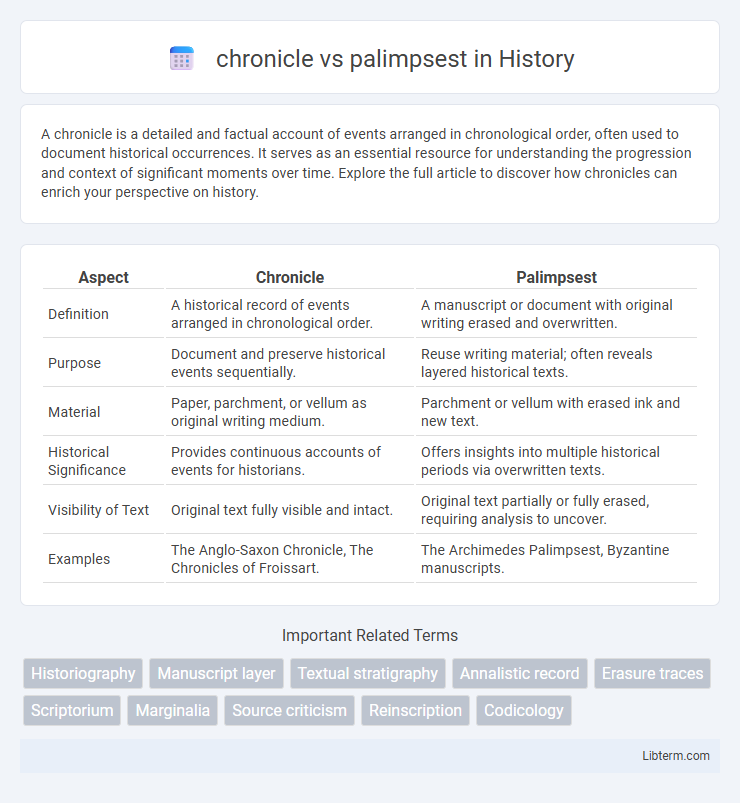A chronicle is a detailed and factual account of events arranged in chronological order, often used to document historical occurrences. It serves as an essential resource for understanding the progression and context of significant moments over time. Explore the full article to discover how chronicles can enrich your perspective on history.
Table of Comparison
| Aspect | Chronicle | Palimpsest |
|---|---|---|
| Definition | A historical record of events arranged in chronological order. | A manuscript or document with original writing erased and overwritten. |
| Purpose | Document and preserve historical events sequentially. | Reuse writing material; often reveals layered historical texts. |
| Material | Paper, parchment, or vellum as original writing medium. | Parchment or vellum with erased ink and new text. |
| Historical Significance | Provides continuous accounts of events for historians. | Offers insights into multiple historical periods via overwritten texts. |
| Visibility of Text | Original text fully visible and intact. | Original text partially or fully erased, requiring analysis to uncover. |
| Examples | The Anglo-Saxon Chronicle, The Chronicles of Froissart. | The Archimedes Palimpsest, Byzantine manuscripts. |
Defining Chronicle and Palimpsest
A chronicle is a detailed and continuous record of events arranged in chronological order, often used to document historical occurrences with clarity and precision. A palimpsest refers to a manuscript or piece of writing material where the original text has been erased or scraped off to make room for new writing, preserving traces of the earlier content beneath. While chronicles emphasize linear documentation, palimpsests reveal layers of textual history, showcasing the act of rewriting and historical transformation over time.
Historical Origins of Chronicles
Chronicles originated as historical records in ancient civilizations, serving as year-by-year accounts that documented significant events in a linear, factual manner. These early chronicles, found in Mesopotamian cuneiform tablets and Egyptian annals, established a foundation for systematic history-keeping by listing events chronologically without extensive interpretation or thematic reorganization. In contrast, a palimpsest refers to a manuscript page reused for writing after the original text was erased, often revealing layered histories through its physical composition rather than a structured historical narrative.
The Evolution of Palimpsests
Palimpsests represent a layered textual evolution, where original writings are partially erased and overwritten, revealing historical narratives through multiple temporal strata. Unlike a straightforward chronicle that records events sequentially, palimpsests preserve diverse voices and hidden histories within a single manuscript, highlighting the dynamic interplay of memory and erasure. The evolution of palimpsests illustrates cultural, linguistic, and material reuse practices, offering invaluable insights into historical record-keeping and manuscript conservation.
Structure and Format Comparison
Chronicles present information in a linear, chronological sequence, emphasizing clear temporal progression with dated entries or events. Palimpsests exhibit a layered format where original texts are overwritten or integrated with newer material, creating a composite document that reveals multiple historical layers. The structural complexity of palimpsests demands specialized analysis to decipher overlapping scripts, while chronicles maintain straightforward readability through sequential narration.
Purposes and Uses in Documentation
Chronicles serve as linear, time-ordered records designed to document events sequentially for historical accuracy and reference. Palimpsests, often found in manuscript studies, are reused documents where original texts are overwritten, indicating purposes of economical reuse and historical layering in documentation. Both highlight different documentation approaches: chronicles prioritize clear temporal organization, while palimpsests reveal the evolution and conservation of textual information.
Literary Significance in History
Chronicles serve as straightforward historical records documenting events in chronological order, preserving factual details and timelines essential for understanding historical contexts. Palimpsests, by contrast, embody layered textual histories, revealing the complexities of cultural memory and reinterpretation through overwritten manuscripts that preserve traces of earlier narratives. The literary significance of both lies in their complementary roles: chronicles provide foundational historical data, while palimpsests offer insights into the persistence and transformation of texts, enriching the study of historical and literary evolution.
Preservation Challenges and Solutions
Chronicles often face preservation challenges due to their susceptibility to physical deterioration, ink fading, and paper brittleness, necessitating climate-controlled storage and digitization to ensure longevity. Palimpsests present unique restoration complexities because their underlying texts are erased or overwritten, requiring advanced multispectral imaging and digital enhancement techniques to recover hidden writings. Both forms benefit from modern archival technologies and conservation science to address their distinct preservation needs effectively.
Notable Examples in World Archives
Notable examples in world archives highlight the distinct nature of chronicles versus palimpsests, with the Anglo-Saxon Chronicle serving as a seminal medieval historical record meticulously detailing events year-by-year. In contrast, the Archimedes Palimpsest, preserved in the Walters Art Museum, reveals an ancient manuscript overwritten with religious texts but recovered through multispectral imaging to unveil original Greek mathematical treatises. These artifacts emphasize the layered narrative styles: chronicles as linear, chronological accounts, while palimpsests offer complex, multi-era documentation essential for reconstructing historical knowledge.
Influence on Modern Recordkeeping
Chronicles provide a linear, factual account of events that shape modern recordkeeping by prioritizing accuracy and chronological order. Palimpsests, with their layered and overwritten texts, influence contemporary archival practices by highlighting the importance of document preservation and the reinterpretation of historical records. Together, they inform modern systems that balance the integrity of original records with the need for continual updating and contextualization.
Chronicle vs Palimpsest: Key Differences
Chronicle and palimpsest differ primarily in purpose and form; a chronicle is a factual, sequential historical record, while a palimpsest is a manuscript or document written over an earlier text, often revealing layers of historical writing. Chronicles focus on preserving events in chronological order to provide clear historical narratives, whereas palimpsests offer insights into textual reuse and the evolution of written material over time. The key distinction lies in the chronicle's role as a transparent historical account versus the palimpsest's characteristic of containing overwritten and partially erased writings.
chronicle Infographic

 libterm.com
libterm.com